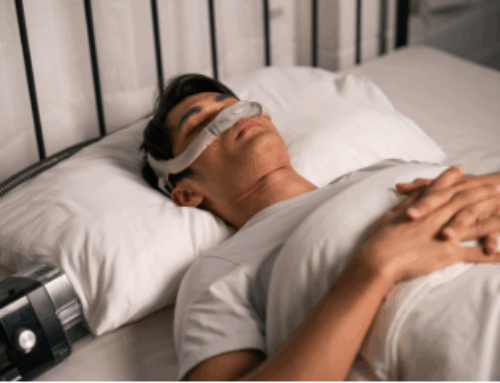Have you ever woken up and had no idea where you were or what time it was? Maybe you sat up in bed, said something strange, or felt totally out of it. If that sounds familiar, you might have had a confusional arousal.
These episodes can be scary, but they are more common than you might think.
What are confusional arousals?
Confusional arousals are a type of sleep disorder where you act confused or strange as you wake up or just after waking. During an episode, it might seem like you don’t know where you are or what you’re doing.
Your behavior can include slow speech, confused thinking, poor memory, and giving blunt or unclear answers to questions. You may look awake, but your mind feels foggy and unclear. Often, these episodes happen when someone else has to physically wake you up.
This kind of disorder is part of a group of sleep disorders called non-REM parasomnias. Non-REM parasomnias usually arise as a result of an incomplete awakening from deep sleep, also known as slow wave or stage N3 sleep. Other non-REM parasomnias include sleepwalking and sleep terrors.
Why do they happen?
Confusional arousals happen when your brain has trouble fully waking up from deep sleep. Instead of making a smooth switch from sleep to wakefulness, part of your brain stays asleep while another part wakes up. This mix-up can lead to confusion or strange behavior.
Why do some people have confusional arousals?
Confusional arousals can affect anyone, but some people are more likely to have them. Often, it runs in families. If a close relative has had episodes like this, your chances may be higher too.
Your lifestyle can also play a big role. Working overnight shifts or having a schedule that keeps changing can throw off your sleep rhythm. When your body clock is out of sync, your brain may struggle to wake up the right way, leading to confusion.
Mental health conditions like depression or bipolar disorder can increase the risk too, as can other sleep disorders like insomnia or hypersomnia. Also, not getting enough sleep can make confusional arousals more likely.
In fact, a study published in Neurology found that the majority of confusional arousals (84%) were associated with sleep/mental disorders or psychotropic drugs. Researchers found that sleep disorders were present for more than 70% of confusional arousals, with those with a circadian rhythm sleep disorder or who slept nine or more hours a night at higher risk to experience a confusional arousal.
Sometimes, specific events can trigger an episode. These include drinking alcohol before bed, using certain medications or drugs, or even being woken up suddenly. Sleep disorders like sleep apnea or periodic limb movements can also cause your brain to wake up in an unusual way.
How common are confusional arousals?
You’re not alone if this has happened to you. Confusional arousals are especially prevalent in children and adults under 35.
These episodes most often appear in early childhood, around age 2. They tend to be harmless, though they can be alarming for parents to witness. In most cases, confusional arousals of early childhood diminish after age 5.
One large study found that 17.3% of children between ages 3 to 13 years experienced confusional arousals. The lifetime prevalence is even higher — 18.5% of people have had an episode at some point in their lives. Among adults over age 15, about 3% to 4% experience confusional arousals.
Confusional arousals, along with sleepwalking and sleep terrors, are considered disorders of arousal. These are most common in children and typically resolve by puberty. For some, however, they may persist into adulthood.
Confusional arousals affect men and women at the same rate.
Are confusional arousals dangerous?
In most cases, confusional arousals aren’t harmful, but they can be unsettling to witness. A person may sit up in bed, mumble, or look right through you without responding. This behavior can seem strange or even a little scary, especially for parents or bed partners.
In children, these episodes are usually harmless and don’t last long. Most end within five to 15 minutes. However, because the child may look confused or agitated, parents often feel the urge to step in. Trying to comfort or wake a child during an episode might actually make things worse. It can lead to more confusion or a longer event.
For adults, confusional arousals are usually not dangerous, but in rare cases, an episode may include unusual or aggressive behavior. These extreme reactions are uncommon, but they can be upsetting or even unsafe if the person lashes out during the episode.
Even though these events can look alarming, most people with confusional arousals don’t need to worry about them being serious or harmful.
What can help?
Confusional arousals often happen when sleep is broken up by other sleep problems. Treating those problems can help reduce the episodes.
For children, sticking to a regular sleep schedule every day and making sure they get enough sleep is important. If episodes keep happening, gently waking your child about 15 minutes before the usual time may help.
In some cases, medications might be recommended to help manage confusional arousals.
When to get help
If you or someone you live with often wakes up confused or acts strangely during the night, don’t ignore it. A sleep doctor can do a sleep study to see what’s causing the problem and recommend treatment.
Use the AASM’s sleep center directory to get help from the sleep team at an accredited sleep center.
Medical review by Ahmed Saleh, MD
Related:
- Comparing child parasomnias
- Sleepwalkers sometimes remember their actions
- Acting out dreams linked to developing dementia
- Hypnosis may help people with parasomnias such as nightmares, sleepwalking





